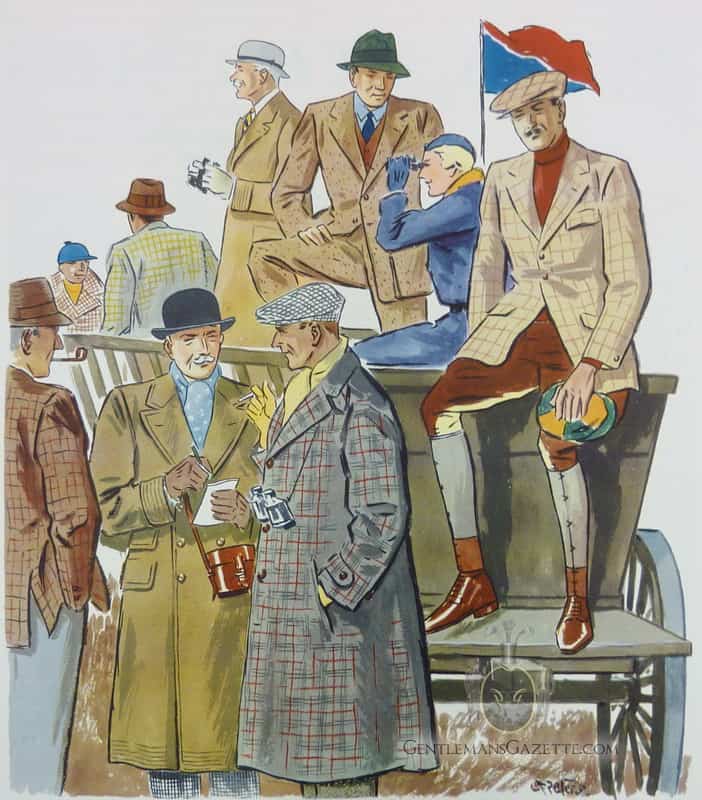Beginning in 1933, combinations with odd jackets emerged as a men’s fashion trend. Americans derived their inspiration for this trend from the British and their colorful, traditional country clothing. As such, American men’s fashion in the mid 1930’s had its fair share of tweed Norfolk jackets, overcoats and shooting suits! In Britain, point-to-point racing has always been as dear to the hearts of the British sporting world as the royal British lion itself. Therefore, today’s fashion illustration by C.F. Peters portraits a typical spectator event of the English countryside. While color is of great importance, the textures of luxurious Shetlands and hand-loomed Donegal Tweeds – sometimes with bold over checks and plaids – also create a nice atmosphere and break the dull monotony charcoal and navy blue worsted business suits.
Fashion Illustration – English Country Fashions By C.F. Peters

Let’s take a closer look at the individuals: The gent on the very left wears a district plaid single breasted sport coat with side vents (which were anything but the norm during the period), grey flannel trousers and snap brim hat with a longer nap, hence the slight sheen. The individual to his right wears a double breasted covert coat with cuffs and several rows of decorative stitching on the cuffs and bottom seam, a black and white Shepherd check suit, a pale blue foulard scarf, a black bowler felt hat and buff-brown pigskin gloves. The man right next to him wears a stunning single breasted notched lapel raglan sleeve topcoat with a great pattern, lovat green herringbone cheviot suit, black and white Shepherd check cap, pale yellow cashmere scarf and yellow buckskin gloves. The gentleman with the mustache sitting on the very right wears a single breasted two button Harris tweed riding coat (also called a sacque) with a windowpane overplaid and a flap on the chest pocket. He also sports fairly closed quarters, a pair of bark-brown colored heavy twill breeches, brown Blucher riding shoes and a wine colored turtleneck sweater. The matching cap creates a harmonious outfit overall. The figure in the center background (next to the lady in blue) is wearing a single breasted three-button notched lapel suit in an unusual tan Donegal tweed with red sprinkles, a blue oxford shirt, a navy blue wool tie with a tiny knot, a tan vest and a green felt hat. To the left of this figure, we find an elegant men in a single breasted covert coat, a yellow and blue striped tie and a grey bowler hat. The remaining man showing with his back turned wears a greenish-grey tweed jacket with a bright orange overplaid and a brown felt hat with a bow in the back. He seems to be talking to the chap with a plaid overcoat. Overall, this illustration perfectly shows how colorful the British used to dress. The British period drama, Downton Abbey, set in the 1910’s, also indulges us with some nice tweeds and caps, just like in this picture.
The Odd Jacket
In 1935, few fashions created more interest than the pronounced vogue for wearing odd jackets with contrasting slacks and waistcoats. This trend was responsible for the very popular mixed-suit ensembles which could be seen in the US at the time. With all the inspiration coming from the UK, the preferred cloth for sportscoats was naturally Harris tweed, Shetland, cheviot, Irish homespun, Donegal tweed or gabardine. Since double breasted coats were higher up on the formality scale, odd jackets were exclusively single breasted with a notched lapel and two or three buttons. Unlike today, the jackets featured all kinds of details, especially in the back, with combinations of belts and by-swing, golf or shooting pleats. The more fashionable sports jackets back then were tailored with a center vent or occasionally side vents, regular pockets with flaps and a cash pocket. These odd jackets were slightly longer than regular coats, as you can see at the gentleman on the far right. Otherwise, they follow pretty much the same lines as those of the single breasted fabric jackets, unless one opted for a Norfolk jacket – but we will focus on this iconic garment in a separate post later on.

Hi, i loved the article on the odd jacket , would love to find a mens pattern for one 54L if you may know please email or send any more info to delane roland 384 stallion rd. inman s.c. u.s.a 29349.